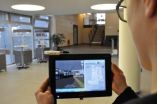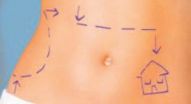(Press-News.org) A smartphone with GPS functionality is a delightful tool. It guides its owner safely and with certainty through the streets of an unfamiliar city. But after arriving at the destination, all too often the orientation is gone, because as soon as you enter a building, you lose contact with the GPS satellites. Then you are on your own – whether in the interminable hallways of the trade fair complex, or inside one of the branches of the local megaplex shopping mall. "Wouldn't it be helpful," Harald von Rosenberg thought to himself, "if at such moments the smart phone could quickly shift to an interior space navigator, and point the way through the rows of shops and stairwells?" Well, that is absolutely possible, as the project manager for "motion control systems" at the Stuttgart-based Fraunhofer Institute for Manufacturing Engineering and Automation IPA now demonstrates through the "MST-Smartsense" cooperation project from the German Federal Ministry for Education and Research BMBF. The project is a joint collaboration that also brings together companies such as Robert Bosch GmbH, Bosch Sensortec GmbH, Binder Elektronik GmbH, AEMtec GmbH, and Sensitec GmbH with the Fraunhofer Research Institution for Modular Solid State Technologies EMFT and the Fraunhofer Institutes for Reliability and Microintegration IZM and for Electronic Nano Systems ENAS. These partners developed a sensor module for navigating interior spaces that is the size of a fingernail – and thus predestined for use in a smartphone.
Sensors detect length of stride
Similar to conventional pedometers, the module registers how fast and how far a person is walking. That said, it is much more precise and intelligent than the customary devices found on the market, because it even registers the direction in which the user is walking. "There has never before been a device so small that can accomplish so much," says von Rosenberg. Basic pedometers initially have to be programmed. Body height, length of stride – all these data must be stored by the user before he or she starts to walk. That could be a hindrance if multiple individuals use the same counter. Moreover, conventional devices are not very accurate. Unlike the new navigation sensor from Stuttgart: located right inside the tiny module are several sensors which are processed combined. These include an acceleration sensor that registers the motion of the body, and a magnetic field sensor that measures the alignment of the body through its position in relation to the earth's magnetic field. In tandem, they map a highly precise movement pattern. "Sensor fusion" is the term von Rosenberg uses to refer to such intelligent coupling of multiple sensors. The fascinating thing is that the module does not have to be calibrated by the user. On its own, it detects if the individual has long legs, or is just taking baby steps. This is possible because von Rosenberg initially trained the software using the stride patterns of various individuals. The sensor instantly registers how an individual is walking and can estimate the stride length exactly.
Display indicates the ideal walk route
Naturally, the interior space navigator only functions if it knows the building. For this purpose, soon smartphones will automatically download three-dimensional building plans from the Internet. These are coupled with the sensor module to display a user's, current position on the smartphone. Even more: the ideal walk route also appears on the display. Building plans can also be fed automatically to the cellular device as soon as you enter a building. It would also be possible to apply a two-dimensional QR code on the layout plan at the entrance of the building. Users could then scan the code with their smartphone, to download the corresponding map.
And there is yet another element that distinguishes the new sensor module. It has its own small microcomputer that processes the sensor's measurement values into clear data – like a degree figure for visual orientation, or the length of a segment of travel. These can be used directly by the smartphone. By contrast, conventional sensors only produce basic raw data that another processor has to calculate into discrete data. "Unlike what we typically find, the MST-Smartsense Sensor can be installed directly into a smartphone or tablet computer without any additional elements, and supply apps with data," says von Rosenberg. Since the sensor module works autonomously, it does not have to rely on the computer capacity of the smartphone's built-in processor. It uses its own small processor that needs substantially less power. That relieves the device's battery.
A demonstration of the new indoor navigation can be seen at the trade show Sensor+Test 2012 from May 22 to 24 in Nuremberg, at the Fraunhofer joint exhibition booth in Hall 10, Booth 202. There, IPA researchers will present another example of a successful sensor fusion system: a navigation module for robots and mobile measurement systems that, using the human eye as its model, additionally secures its position through a camera image.
INFORMATION:
Navigating the shopping center
2012-05-12
ELSE PRESS RELEASES FROM THIS DATE:
First satellite tag study for manta rays reveals habits and hidden journeys of ocean giants
2012-05-12
Using the latest satellite tracking technology, conservationists from the Wildlife Conservation Society, the University of Exeter (UK), and the Government of Mexico have completed a ground-breaking study on a mysterious ocean giant: the manta ray.
The research team has produced the first published study on the use of satellite telemetry to track the open-ocean journeys of the world's largest ray, which can grow up to 25 feet in width. Researchers say the manta ray—listed as "Vulnerable" by the International Union for Conservation of Nature (IUCN)—has become increasingly ...
Revenue-driven surgery drives patients home too early
2012-05-12
COLLEGE PARK, Md. - Revenue-driven surgery and poor planning drive some surgical patients home too early, concludes a pair of logistical studies conducted by researchers at the University of Maryland's Robert H. Smith School of Business.
The studies show a correlation between readmission rates and how full the hospital was at the time of discharge, suggesting that patients went home before they were healthy enough.
The researchers recommend better planning and other logistical solutions to avoid these problems.
The studies appear in the two most recent issues of the ...
Low-cost nanosheet catalyst discovered to split hydrogen from water
2012-05-12
UPTON, NY – Hydrogen gas offers one of the most promising sustainable energy alternatives to limited fossil fuels. But traditional methods of producing pure hydrogen face significant challenges in unlocking its full potential, either by releasing harmful carbon dioxide into the atmosphere or requiring rare and expensive chemical elements such as platinum.
Now, scientists at the U.S. Department of Energy's (DOE) Brookhaven National Laboratory have developed a new electrocatalyst that addresses one of these problems by generating hydrogen gas from water cleanly and with ...
Yeoman Technology Group Announces Date for "Ugly Baby" Online Product Data Webinar
2012-05-12
Yeoman Technology Group has announced the date for its "Your Ugly Baby - Getting a Handle on How Your Products Look Online" webinar event. The webinar, which will take place live on Wednesday, June 6th at 10 am Eastern, will be provided free of charge, but registration is limited. Interested executives may register via the Yeoman website: http://www.yeomantechnologies.com/events
According to Yeoman Technology Group President and event presenter Mike Healey, "A recent Yeoman study of over 1,000 items sold on Amazon found a whopping 70% contained errors ...
Bayer tried to reduce risks of MIC at WV plant, but didn't implement all hazard controls
2012-05-12
WASHINGTON — Bayer CropScience sought to reduce risks associated with the manufacturing and storage of the toxic chemical methyl isocyanate (MIC) at its processing plant in Institute, W.Va., says a new congressionally mandated report from the National Research Council. However, the company did not make an effort to incorporate all possible hazard control methods, and the report found that not all chemical manufacturing plants have adopted safer processes that aim to minimize or eliminate hazards. The committee that wrote the report recommended that the U.S. Chemical Safety ...
Blue Steel Acquisitions Concern as Businesses Struggle to Understand Consumers' Needs
2012-05-12
Blue Steel Acquisitions confirms consumers do not ask what the message of a marketing campaign is; therefore it is so important for businesses to understand their customers' needs. A study conducted by Gartner (Business Insider), a leading information technology research and advisory company, reports that companies have to step up their game when it comes to multi-channel marketing. Mark Fodor, CEO of Cross View confirms that the problem lies in the 's' word: "The opportunity for merchants to become more cross-channel is there, but they need to learn how to communicate ...
Mild traumatic brain injury may contribute to brain network dysfunction
2012-05-12
RICHMOND, Va. (May 10, 2012) – Even mild head injuries can cause significant abnormalities in brain function that last for several days, which may explain the neurological symptoms experienced by some individuals who have experienced a head injury associated with sports, accidents or combat, according to a study by Virginia Commonwealth University School of Medicine researchers.
These findings, published in the May issue of the Journal of Neuroscience, advance research in the field of traumatic brain injury (TBI), enabling researchers to better understand what brain structural ...
Gene therapy for hearing loss: Potential and limitations
2012-05-12
Regenerating sensory hair cells, which produce electrical signals in response to vibrations within the inner ear, could form the basis for treating age- or trauma-related hearing loss. One way to do this could be with gene therapy that drives new sensory hair cells to grow.
Researchers at Emory University School of Medicine have shown that introducing a gene called Atoh1 into the cochleae of young mice can induce the formation of extra sensory hair cells.
Their results show the potential of a gene therapy approach, but also demonstrate its current limitations. The extra ...
Leighmans Latest Gift, the iPrint, Wins Latest Lions' Lair Competition
2012-05-12
Leighmans.com, one of the leading providers of corporate gifts and branded merchandise in the UK, has been recognised at this year's "Lions' Lair" business innovation awards.
The Lions' Lair judging panel this year awarded first place to the new Leighmans product the 'iPrint', an adhesive strip which is fitted to mobile devices and phones to let people use them in wet weather and when wearing bulky gloves.
Leighmans reports that the iPrint has been a huge success with its customers - companies which have mobile workers and staff members who commute have ...
In metallic glasses, researchers find a few new atomic structures
2012-05-12
MADISON – Drawing on powerful computational tools and a state-of-the-art scanning transmission electron microscope, a team of University of Wisconsin-Madison and Iowa State University materials science and engineering researchers has discovered a new nanometer-scale atomic structure in solid metallic materials known as metallic glasses.
Published May 11 in the journal Physical Review Letters, the findings fill a gap in researchers' understanding of this atomic structure. This understanding ultimately could help manufacturers fine-tune such properties of metallic glasses ...


